
Owning a block of flats can present various challenges, especially when it comes to fire safety.
Imagine a situation where you’re uncertain about whether a fire risk assessment is needed for your specific property. Understanding the circumstances that trigger this requirement is essential, not just for legal compliance but, more importantly, for the safety of those residing in the building.

Let’s explore the nuances of when a a fire risk assessment becomes a necessity for flats and how it impacts your responsibilities as a property owner.
Understanding Legal Requirements
How do legal requirements outline the responsibilities for fire risk assessments in flats?
Legal obligations for fire safety in flats are stringent, primarily governed by the Fire Safety Order (2005). As a building owner, my responsibility includes conducting regular fire risk assessments for blocks of flats with multiple occupants to ensure compliance and mitigate potential fire hazards. Failure to adhere to these legal requirements could result in severe consequences, with the responsible person held liable for any non-compliance.
To meet these legal obligations effectively, it’s crucial to seek professional services for expert guidance in conducting thorough and up-to-date fire risk assessments. These assessments should encompass evaluating the likelihood of a fire, inspecting potential sources of ignition, assessing building layout, occupancy, and ensuring the safety of vulnerable residents. By staying informed and proactive in fulfilling these legal responsibilities, I can contribute to creating a safer living environment for residents in flats and demonstrate a commitment to fire safety compliance.
Components of Risk Assessment
The evaluation of potential fire hazards and safety measures constitutes the core of risk assessment in flats. Assessments involve scrutinizing sources of ignition, accelerants, shared areas, fire doors, and suppression systems to determine the likelihood of a fire.
It’s crucial to consider the building layout, occupancy, and any vulnerable residents residing in the property. Additionally, staff training, escape routes, and fire prevention standards should be thoroughly assessed to ensure comprehensive fire risk management.
Regular assessments are essential for maintaining a safe living environment, and reassessment is recommended based on the building’s risk profile. It’s also important to conduct assessments after any significant changes like a fire incident, construction work, ownership transfer, or increased occupancy.
Seeking guidance from professionals can provide valuable insights into specific risk factors and necessary safety measures tailored to the property’s unique characteristics.
Importance of Regular Assessments

Regularly conducting fire risk assessments in flats is essential for maintaining a safe living environment and minimizing potential hazards. These assessments should not be seen as a one-time task but rather as an ongoing process to ensure the safety of residents. By frequently evaluating fire risks, landlords and building owners can address any issues promptly and implement necessary safety measures. Here is a quick overview of why regular assessments are crucial:
| Importance of Regular Assessments |
|---|
| Identifying emerging hazards |
| Ensuring compliance with regulations |
| Enhancing overall fire safety |
| Promoting a proactive safety culture |
Regular assessments play a key role in staying ahead of potential fire risks and creating a secure environment for everyone in the building. Therefore, it is imperative to prioritize and schedule these evaluations regularly to maintain a high level of safety and preparedness.
Role of Fire Dampers
Having a clear understanding of the function and significance of fire dampers is crucial for ensuring effective fire protection in buildings. Fire dampers are essential components of fire safety systems in flats and high-rise buildings. These devices help prevent the spread of fire and smoke throughout a building by closing off ducts and airways in the event of a fire.
Regular maintenance and inspection of fire dampers are vital to ensure they remain operational and can effectively contain fire within specific areas of a building. Failure to maintain fire dampers can compromise the overall fire safety of a property and put occupants at risk.
Recommendations for Effective Assessments
For effective assessments, prioritize compliance with legal requirements and responsibilities.
Regularly updating and reviewing fire risk assessments is crucial to maintaining a safe living environment in flats. Seeking professional guidance and expertise can ensure thorough evaluations and accurate identification of potential fire hazards. Maintenance and inspection of fire protection systems, including fire dampers, should be a priority to enhance overall fire safety measures.
Assessments should be conducted regularly, with reassessments based on the building’s risk profile. It’s recommended to perform assessments after significant events like a fire, changes in occupancy, or construction work. If uncertain about the need for an assessment, consulting with specialists can offer clarity.
Keeping assessments up-to-date and in line with legal obligations not only ensures the safety of occupants but also mitigates legal liabilities for non-compliance. By following these recommendations, landlords can proactively address fire safety concerns and create a secure environment for residents.
Tenant’s Role in Fire Safety
To understand the importance of fire safety in residential properties, it’s crucial for tenants to be aware of their responsibilities in preventing and responding to fire hazards. As a tenant, it’s my duty to avoid fire hazards by not blocking fire escape routes, refraining from smoking inside the property, and avoiding actions like daisy-chaining extension leads that could pose a fire risk.
Promptly reporting potential fire risks to landlords is essential for maintaining a safe living environment. Additionally, being familiar with the fire escape plan of the property I’m renting is vital for quick and safe evacuation in case of an emergency.
Compliance With Fire Safety Law
Ensuring compliance with fire safety laws is a critical responsibility for all individuals involved in managing residential properties. It’s essential to carry out regular fire risk assessments, keeping documentation up to date, and implementing necessary fire safety precautions in common areas. Engaging with tenants on fire safety measures and coordinating with others responsible for fire safety are also crucial aspects of compliance.
Every block of flats must have a designated responsible person overseeing fire safety measures. Evidence of a recent fire risk assessment is required when applying for an HMO license, emphasizing the significance of staying up to date with assessments. Compliance with fire safety laws not only ensures the safety of residents but also protects against legal repercussions.
Therefore, it’s imperative to prioritize fire safety measures and adhere to the regulations set forth to maintain a secure living environment for all occupants.
Assessments in Different Property Types
Assessing fire risks in various property types is essential for ensuring safety compliance and mitigating potential hazards. Different properties have unique characteristics that require specific assessment approaches to address fire safety adequately. Below is a comparison table highlighting key considerations for fire risk assessments in various property types:
| Property Type | Assessment Requirements |
|---|---|
| House in Multiple Occupation (HMO) | Fire risk assessment is mandatory |
| Blocks of Flats | Legal requirement for a fire risk assessment |
| Guest Houses, Holiday Homes, Bed and Breakfasts | Must have a fire risk assessment |
Understanding the distinct demands of each property type enables tailored fire risk assessments to identify and address potential hazards effectively. Compliance with these assessments is crucial in safeguarding occupants and ensuring a proactive approach to fire safety.
Frequently Asked Questions
What Are the Consequences for Landlords if They Fail to Conduct a Fire Risk Assessment for Their Flats?
If landlords fail to conduct a fire risk assessment for flats, consequences may include legal penalties, risk to occupants’ safety, property damage, and insurance issues. It’s crucial for landlords to fulfill this obligation promptly.
Are There Any Specific Regulations Regarding Fire Risk Assessments for Flats Located in Historical Buildings?
When looking at fire risk assessments for flats in historical buildings, specific regulations may apply due to unique structural considerations and preservation requirements. Consulting with experts can ensure compliance and safety in these settings.
How Can Residents in Flats Actively Participate in Fire Safety Measures Beyond Following Evacuation Protocols?
To actively participate in fire safety beyond evacuation protocols, residents in flats can engage in regular fire drills, report potential hazards promptly, ensure smoke alarms are functional, and familiarize themselves with the fire escape plan.
What Are the Potential Challenges Faced by Landlords When Trying to Implement Fire Safety Measures in Shared Accommodation Flats?
Implementing fire safety measures in shared accommodation flats can be challenging for landlords due to varied tenant behaviors, ensuring compliance, and coordinating maintenance. Engaging tenants, regular assessments, and prompt action on potential risks are vital.
Are There Any Emerging Technologies or Innovations That Landlords Can Incorporate Into Their Fire Risk Assessments for Flats to Enhance Safety Measures?
Incorporating emerging technologies like smart smoke detectors and fire suppression systems can enhance safety measures in flats. These innovations offer real-time monitoring and automated response capabilities, improving overall fire risk assessment effectiveness and tenant safety.
Conclusion
In conclusion, conducting regular fire risk assessments for flats is essential to ensure the safety of occupants and comply with legal requirements.
By understanding the components of risk assessments, the role of fire dampers, and the importance of proactive measures, property owners can effectively manage fire risks.
Stay informed, prioritize fire safety, and work collaboratively with tenants to create a safe living environment for all.



